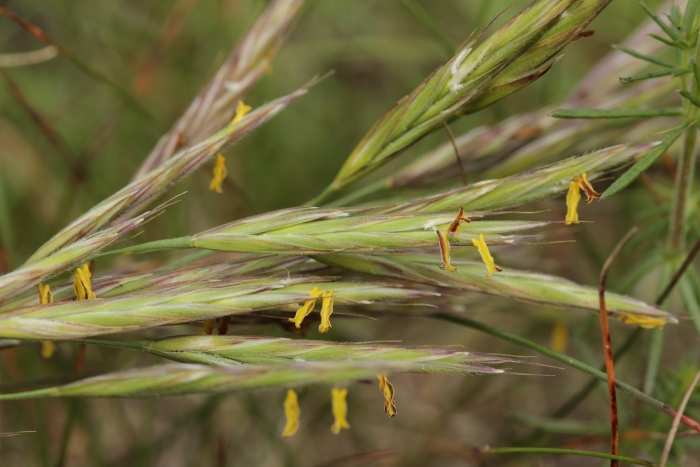Erect Brome
(Bromus erectus)
Erect Brome (Bromus erectus)
/
/

bjoerns
CC BY-SA 4.0
Image By:
bjoerns
Recorded By:
Copyright:
CC BY-SA 4.0
Copyright Notice:
Photo by: bjoerns | License Type: CC BY-SA 4.0 | License URL: http://creativecommons.org/licenses/by-sa/4.0/ | Rights Holder: bjoerns | Publisher: iNaturalist | Date Created: 2021-06-19T11:44:45-07:00 |

























Estimated Native Range
Summary
Bromus erectus, commonly known as erect brome or meadow brome, is a perennial grass that forms dense, tufted clumps and can reach up to 47 inches in height. It is native to dry grasslands, open woodlands, and meadow habitats across Europe, extending into western Asia. This species is particularly adapted to calcareous soils and thrives in well-drained conditions with full sun to partial shade. Erect brome is characterized by its upright growth habit and slender, arching stems. The inflorescences are open panicles with spikelets that turn a golden brown at maturity during the summer months.
Erect brome is valued for its ability to form a dense sward, which can be beneficial for erosion control and as a forage grass in pastureland. It is also used in wildflower meadows and naturalistic plantings to provide structure and texture. While it has a moderate growth rate, it is relatively low maintenance once established, requiring minimal additional watering in suitable climates. However, it is potentially invasive in some regions outside its native range, and gardeners should consult local regulations before planting. In areas where it is not invasive, it can be a useful addition to ecological gardens, supporting a variety of wildlife.CC BY-SA 4.0
Erect brome is valued for its ability to form a dense sward, which can be beneficial for erosion control and as a forage grass in pastureland. It is also used in wildflower meadows and naturalistic plantings to provide structure and texture. While it has a moderate growth rate, it is relatively low maintenance once established, requiring minimal additional watering in suitable climates. However, it is potentially invasive in some regions outside its native range, and gardeners should consult local regulations before planting. In areas where it is not invasive, it can be a useful addition to ecological gardens, supporting a variety of wildlife.CC BY-SA 4.0
Plant Description
- Plant Type: Grass
- Height: 1.5-2.5 feet
- Width: 0.5-1 feet
- Growth Rate: Moderate
- Flower Color: N/A
- Flowering Season: Spring, Summer
- Leaf Retention: Deciduous
Growth Requirements
- Sun: Full Sun
- Water: Medium
- Drainage: Medium
Common Uses
Border Plant, Low Maintenance, Rabbit Resistant
Natural Habitat
Native to dry grasslands, open woodlands, and meadow habitats across Europe and western Asia
Other Names
Common Names: Upright Brome, Meadow Brome
Scientific Names: , Bromus erectus, Bromopsis alexeenkoi, Bromopsis aspera, Bromopsis caprina, Bromopsis erecta, Bromopsis erecta, Bromopsis erecta subsp. alexeenkoi, Bromopsis erecta subsp. gordjaginii, Bromopsis erecta subsp. longiflora
GBIF Accepted Name: